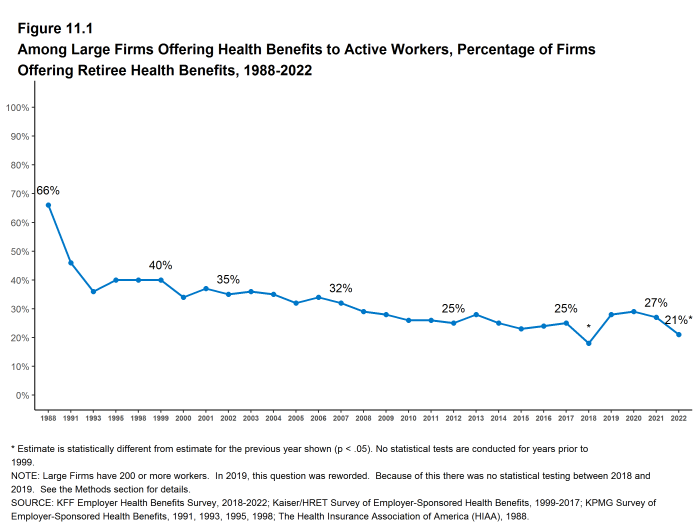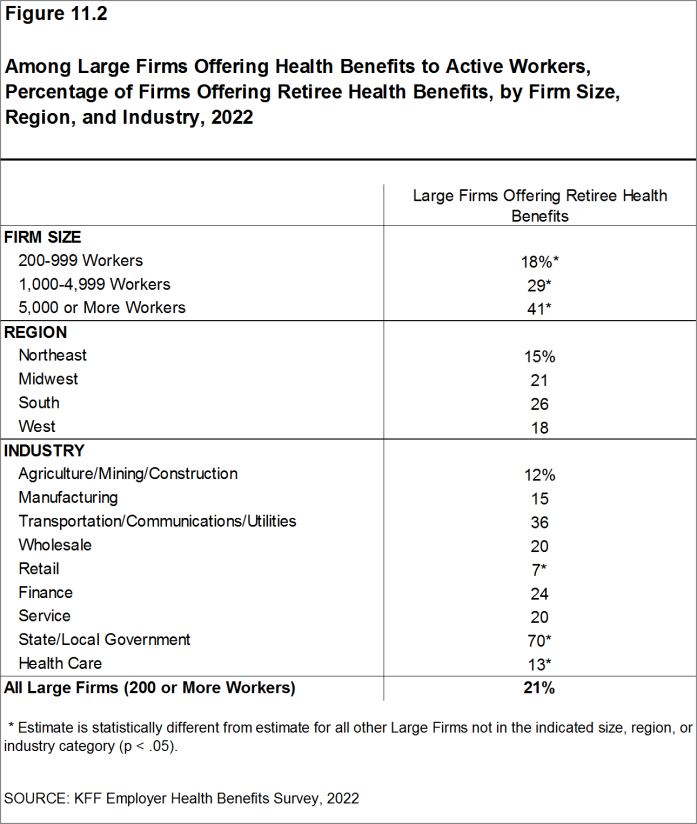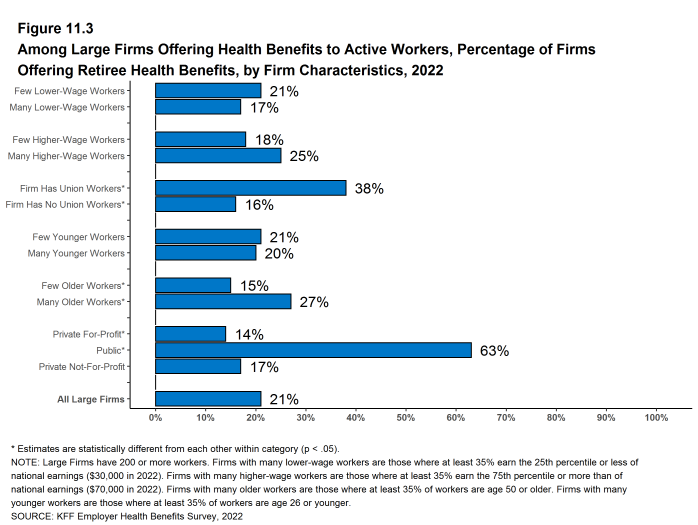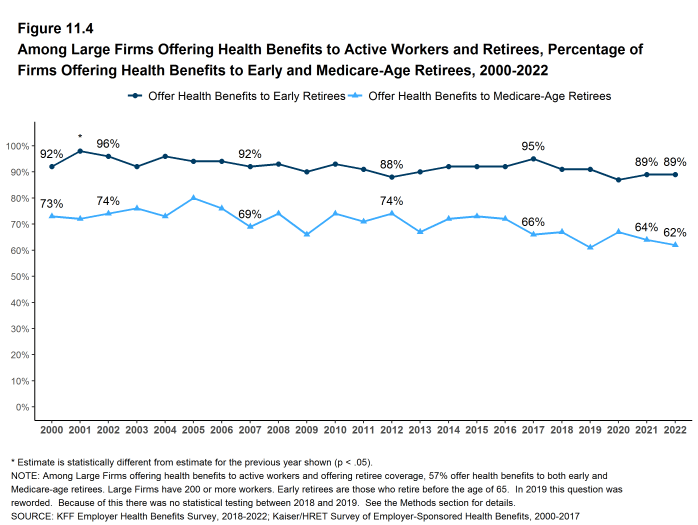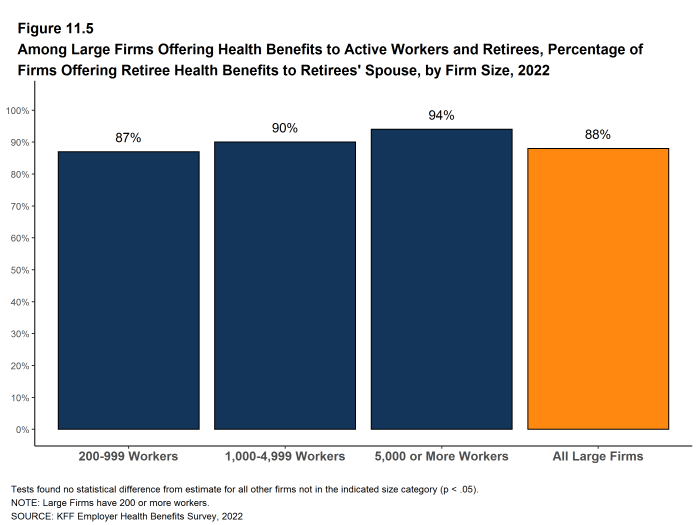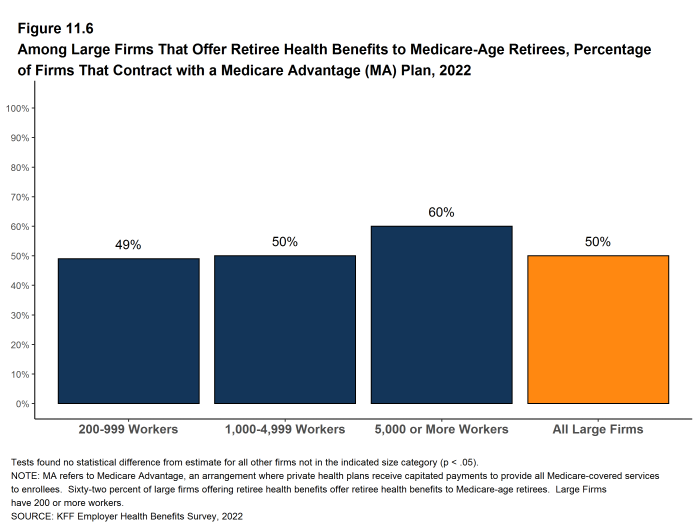2022 Employer Health Benefits Survey
Section 11: Retiree Health Benefits
Retiree health benefits are an important consideration for older workers making decisions about their retirement. Retiree benefits can be a crucial source of coverage for people retiring before Medicare eligibility. For retirees with Medicare coverage, retiree health benefits can provide an important supplement to Medicare, helping them pay for cost sharing and benefits not otherwise covered by Medicare.
This year’s survey finds that 21% of large firms offering health benefits offer retiree health benefits, a decrease from the percentage in 2021 (27%).
This survey asks retiree health benefits questions only of large firms (200 or more workers).
EMPLOYER RETIREE BENEFITS
- In 2022, 21% of large firms that offer health benefits offer retiree health benefits for at least some current workers or retirees, lower than the percentage last year [Figure 11.1]. In 2019, we modified the question that we use to ask firms whether or not they provide retiree health benefits, to explicitly say “yes” if they still had some retirees getting coverage even if they terminated retiree health benefits (for current workers) or if they had current employees who will get retiree health coverage in the future. For this reason, estimates of retiree health benefits from 2019 and after are not comparable to prior survey estimates.
- Retiree health benefits offer rates vary considerably by firm characteristics.
- Among large firms offering health benefits, the likelihood that a firm will offer retiree health benefits increases with firm size [Figure 11.2].
- The share of large firms offering retiree health benefits varies considerably by industry [Figure 11.2].
- Among large firms offering health benefits, public employers are more likely (63%) and private for-profit employers are less likely (14%) to offer retiree health benefits than other firm types [Figure 11.3].
- Large firms offering health benefits with at least some union workers are more likely to offer retiree health benefits than large firms without any union workers (38% vs. 16%) [Figure 11.3].
- Large firms offering health benefits with a relatively large share of older workers (where at least 35% of the workers are age 50 or older) are more likely to offer retiree health benefits than large firms with a smaller share of older workers (27% vs. 15%) [Figure 11.3].
Figure 11.1: Among Large Firms Offering Health Benefits to Active Workers, Percentage of Firms Offering Retiree Health Benefits, 1988-2022
Figure 11.2: Among Large Firms Offering Health Benefits to Active Workers, Percentage of Firms Offering Retiree Health Benefits, by Firm Size, Region, and Industry, 2022
COVERAGE FOR EARLY RETIREES AND MEDICARE-AGE RETIREES
- Among large firms offering retiree health benefits, 89% offer benefits to early retirees under the age of 65 and 62% offer them to Medicare-age retirees [Figure 11.4].
- Among all large firms offering health benefits to current workers, 13% offer retiree health benefits to Medicare-age retirees.
- Among large firms offering retiree health benefits, 57% offer benefits to both early and Medicare-age retirees.
BENEFIT ELIGIBILITY
- Among large firms offering retiree benefits, a large share (88%) report offering health benefits to the spouses of retirees [Figure 11.5].
MEDICARE ADVANTAGE
- Fifty percent of large employers offering retiree health benefits to Medicare-age retirees offer coverage to at least some Medicare-age retirees through a contract with a Medicare Advantage plan, similar to last year (45%) [Figure 11.6].

